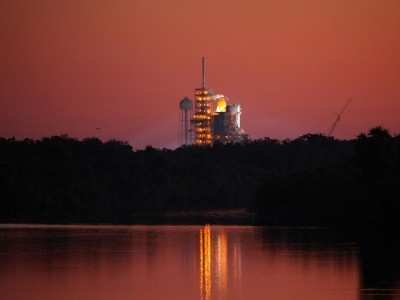Tue, Jan 04, 2011
Engineers Analyze Data On All 108 Stringers
Technicians working on space shuttle Discovery's external fuel
tank in the Vehicle Assembly Building at NASA's Kennedy Space
Center in Florida began repairs Monday on three support beams,
called stringers, that recently were detected to have small cracks
on their tops.

Engineers at various NASA centers continue to analyze data from
testing and X-ray type image scans collected during the past week
of all 108 stringers on the outside of the external tank's
intertank section. The image scans showed four small cracks on
three stringers on the opposite side of the tank from Discovery.
Managers decided Thursday to have those cracks repaired in a
similar fashion to repairs made on cracks on two stringers found
after Discovery's Nov. 5 launch attempt.
The repair work is estimated to take 2-3 days. Any further work
will be evaluated thoroughly during the week after additional data
and analysis are reviewed.

Technicians at NASA's Kennedy Space Center in Florida will also
begin modifications to 34 additional stringers on space shuttle
Discovery's external fuel tank on Tuesday. Crews will fit pieces of
metal, called radius blocks, over the tops of the stringers located
at the external tank's thrust panel area to increase the structural
support of the stringers. The thrust panel areas are located at the
attachment points between the tank and the solid rocket boosters,
which see the most stress during the flight into orbit.
The work is expected to take approximately one week. Teams
currently are performing scans on all of the tank's stringers using
a backscatter device, which bounces radiation off the tank allowing
engineers to see below the foam insulation. Engineers at various
NASA centers continue to analyze testing and imaging data. Managers
will meet again Thursday to determine whether radius block
modifications are needed on the remaining stringers.

Discovery Tank Repairs
The next available launch date for Discovery's STS-133 mission
to the International Space Station remains Feb. 3 at the opening of
a window that extends through Feb. 10.
More News
Light Gun A handheld directional light signaling device which emits a brilliant narrow beam of white, green, or red light as selected by the tower controller. The color and type of>[...]
"The journey to this achievement started nearly a decade ago when a freshly commissioned Gentry, driven by a fascination with new technologies and a desire to contribute significan>[...]
Aero Linx: JAARS, Inc. For decades now, we’ve landed planes on narrow rivers and towering mountains. We’ve outfitted boats and vehicles to reach villages that rarely se>[...]
"Our driven and innovative team of military and civilian Airmen delivers combat power daily, ensuring our nation is ready today and tomorrow." Source: General Duke Richardson, AFMC>[...]
Aircraft Conflict Predicted conflict, within EDST of two aircraft, or between aircraft and airspace. A Red alert is used for conflicts when the predicted minimum separation is 5 na>[...]
 ANN's Daily Aero-Term (04.20.24): Light Gun
ANN's Daily Aero-Term (04.20.24): Light Gun Aero-News: Quote of the Day (04.20.24)
Aero-News: Quote of the Day (04.20.24) ANN's Daily Aero-Linx (04.21.24)
ANN's Daily Aero-Linx (04.21.24) Aero-News: Quote of the Day (04.21.24)
Aero-News: Quote of the Day (04.21.24) ANN's Daily Aero-Term (04.21.24): Aircraft Conflict
ANN's Daily Aero-Term (04.21.24): Aircraft Conflict





